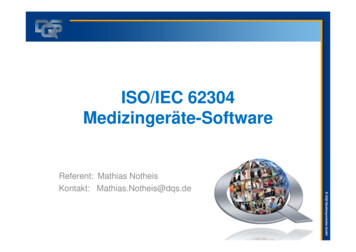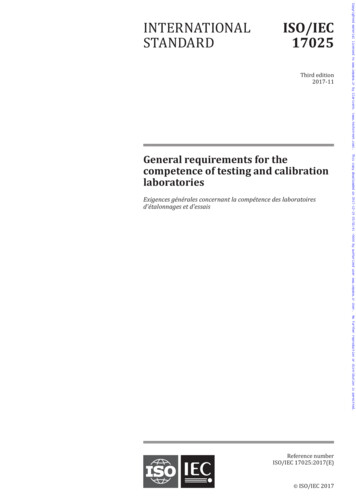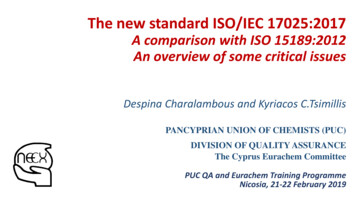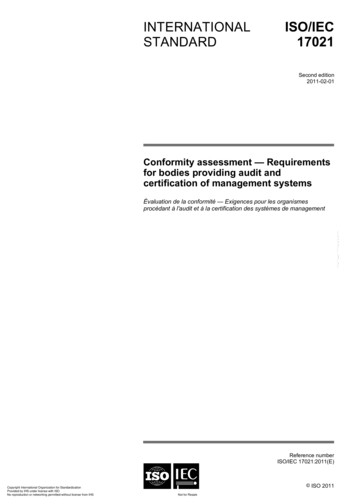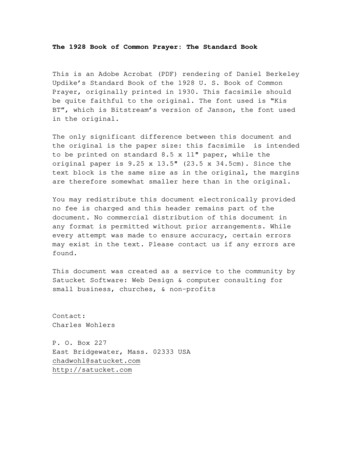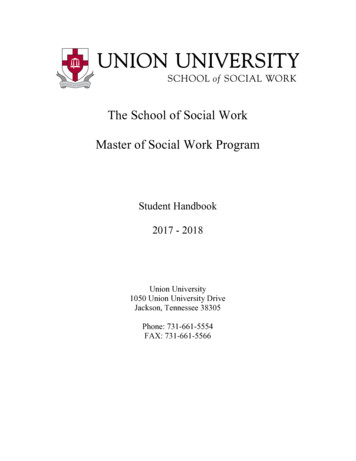
Transcription
Work bookThe standard IEC 61439 in practice
Work book on the seminar delivered by ABBThe standard IEC 61439Basic standards(definitions of personal protection, calculation and test procedures, assessment bases)IEC 60364-4-41IEC / TR 60664-2-1IEC 60529Protection against electric shockInsulation co-ordinationTest devices and test proceduresRequirements for specialinstallations or locationsIEC 60364-7.Installation and connection ofswitchgear and distribution boardsIEC 60364-7-729Operation of electrical installationsEN 50110Low-voltage switchgear andcontrolgear ASSEMBLIES- Protection against electric shock- Protection against unintentionaldirect contact withhazardous live partsEN 50274Safety of machinery,electrical equipment of machinesand mechanisms.Part 1. General requirementsIEC 60204-1Installation and implementation provisionsIEC 61439-1, IEC 61439-2IEC 61439-3Prepared by:Matthias KratzkeJürgen DufnerWork book 2CPC 000 305 B01011
Notes22CPC 000 313 B0101 Work book
Work bookContentsBlue Pages5 – 10Foreword / introduction5Parts of the standard6Why a new standard?7How can the original manufacturer or the manufacturer verify thesafety of an ASSEMBLY?White PagesBuilding / manufacture of the distribution board117111921213Chapter 4 – Routine verificationRoutine verification8How can a low-voltage switchgear and controlgearASSEMBLY be realized safely?Chapter 3 – Building / manufacture of the distribution boardChapter 5 – CE conformity declaration911 - 122CE conformity declarationYellow Pages123 – 165Symbols and abbreviations12311Comparisons and effects in connection with different standards12313Minimum requirements for the type plate – example ABB125Protection against electric shock (IEC 60364-4-41)15Panel Design Configurator software – new article127Overvoltage categories17Panel Design Configurator software – export/import user article data129Characteristics and explanations19Temperature rise verification up to 630 A – solution example131Check list25Data collection tables133Electrical circuits and loads27Verification of temperature rise up to 630 A139Characteristics and explanations29Design verification part I141Main circuits31Design verification part II143Check list35Unit test protocol14537Unit test protocol checklist14739Conformity assessment checklist16141Declaration of conformity163Check list45Examples STRIEBEL & JOHN165Operating and servicing49Our solutions for internal forms of separation50Internal forms of separation51Characteristics and explanations53Check list55Chapter 1 – Collecting the requisite dataConnection to the electrical systemElectrical systems and protective systemsInstallation and environmental conditionsTypical conditions of installations of ASSEMBLIESProtection against mechanical impactsChapter 2 – Distribution board design and design verificationDistribution board design and design verification57Requirements arising from the standard59Characteristics and explanations61Verification of temperature rises67Example calculation74Temperature rise verification up to 630 A75Temperature rise verification pursuant to DIN EN 6089081Verification of the short-circuit withstand strength87Short circuit – key terms89Verification of the Short-circuit withstand strength91Short-circuit current at the supply position95Transformer nominal values table109Characteristics and explanations111Devices from other manufacturers113Form sheet examples115Work book 2CPC 000 305 B0101345
Notes42CPC 000 313 B0101 Work book
Foreword / introductionThis document is designed to assist you and enables us to secure ourcommon success.1This workbook contains general information and proposals for designing, planning and building low voltage switchgear and controlgearASSEMBLIES in compliance with the applicable laws, directives andprovisions.Basic knowledge in electrical engineering is essential for planning lowvoltage switchgear and controlgear ASSEMBLIES.This workbook includes general and special information which isessential for safe, reliable and economical low voltage switchgear andcontrolgear ASSEMBLY operation.In addition, the topics designed to protect people and assets arebeing dealt with.Distribution boards in the low voltage networkDistribution boards serve as link between electrical appliances andusers.They form the visible part of an electrical system and represent theelectrical company having installed the ASSEMBLY.The requirements in terms of flexibility and safety for distributionboards are particularly high:––––Personal protectionProperty protectionHigh operational and functional safetyEase of useSolid design to prevent unprofitable investment:– Optimum adaptability to use cases– Cooperation between user / planner / manufacturerto balance specifications and costsWork book 2CPC 000 313 B01015
Parts of the standard6StandardTitleEditionIEC 61439-0GuidelineApril 2013IEC 61439-1General rules08/14/2011IEC 61439-2Power switchgear and controlgear ASSEMBLIES08/19/2011IEC 61439-3Distribution boards intended to be operated by ordinary persons02/16/2012IEC 61439-4ASSEMBLIES for construction sites11/15/2012IEC 61439-5Assemblies for power distribution in public networks08/25/2014IEC 61439-6Busbar trunking systems05/23/2012PrestandardIEC/TS 61439-7Assemblies for specific applications such as marinas, campingsites, market squares, electric vehicle charging stations and similar02/19/20142CPC 000 305 L0101 Work book
Why a new standard?Who is the manufacturer?Health of the individual is regarded as fundamentalasset within the economic space of the EuropeanUnion.The EU-Commission has therefore made it its goalto elaborate directives, which are then transposedinto national law by Member States.Thus, the low voltage directive is implemented inthe German Product Safety Act.Next to the German Product Safety Act, there isthe Product Liability Act which is designed to protect the user in case of damages.duced a defective product to the market and thatthere is causality between the defective product,the violation of legal rights and the damage. Thequestion whether a manufacturer is responsible forproduct defects puts an unacceptable burden ofproof on the injured party.1This is the reason why a reversed burden of proofis applied here. Meaning that the manufacturer hasto prove that the product was free from defectsin design, workmanship and instructions uponmarketing.Both laws pursue safety targets and are designedto protect people, livestock and property.Regarding product liability for example, injuredparties will only have to demonstrate that their legal rights have been violated and that this violationled to a loss and that the manufacturer has intro-The new standard precisely defines the responsibilities for a marketedproduct. It differentiates between original manufacturer and ASSEMBLY manufacturer.BuildersBuildersSystem manufacturerOriginal manufacturerBuildersASSEMBLYManufacturerWork book 2CPC 000 305 L01017
How can the original manufacturer or the manufacturer verify thesafety of an ASSEMBLY?The new standard describes three design verification processes for ASSEMBLIES and requires aroutine verification for every marketed product.TestingCalculation / measurementApplication of constructive rulessuch as– electrical– mechanical– thermal tests in accordancewith the requirements specified in the standardsuch as– Calculating of temperaturerises or of short-circuit forces– Measurement of clearancesand creepage distancessuch as– specified dimensions– test steps– ASSEMBLY sequencesbased on tested referencedesignsmanufacturer will become original manufacturer for that alteration and will have to carry outthe design verification in accordance with thedescribed procedures.These processes are essentially implementedby the original manufacturer. In case that theASSEMBLY manufacturer does not install anASSEMBLY in compliance with the instructionsof the original manufacturer, the ASSEMBLYIEC 61439ASSEMBLYOriginal manufacturerDesign verification through the original manufacturerTestingCalculation / measurementrulesThe ASSEMBLY manufacturer may:– Proceed to final ASSEMBLY as provided for by the original manufacturer– Deviate from the provisions of the original manufacturer and will thus become originalmanufacturer for this alteration.Routine verificationOperational switchgear ASSEMBLIESThe ASSEMBLY manufacturer always has to implement the routine verification.8Application of constructivePower switchgear and controlgear ASSEMBLIESASSEMBLY manufacturerOriginal manufacturerLow-voltage ASSEMBLY2CPC 000 313 B0101 Work book
How can a low-voltage switchgear and controlgear ASSEMBLY berealized safely?The new standard does not only precisely define the responsibilities ofthe market participants, but also specifies the dimensions of low-voltageswitchgear and controlgear ASSEMBLIES.1In addition it presents the possibilities and limits for the market participants inorder to guarantee to the user safe low-voltage switchgear and controlgearASSEMBLIES.It is also designed to specify the documentation required for low-voltageswitchgear and controlgear ASSEMBLIES and/orthe required verifications.Which are the dimensioning specifications enabling design verification?One important aspect emphasised in the IEC 61439 is the earthing system asthis has important consequences for planing the electrical circuits.Work book 2CPC 000 313 B01019
Notes102CPC 000 313 B0101 Work book
Chapter 1 – collecting the requisite dataConnection to the electrical systemHow are ASSEMBLIES dimensioned?1ASSEMBLIES are dimensioned through the definition of interfacevalues.Installation and3 environmental conditionsOperating and4 servicingConnection to the1 electrical systemCircuits and2 loads1) Connection to the electrical system2) Electrical cicuits and loads––––––– Distribution circuits for load-sidesubdistribution panels– Final circuitsNominal voltage of the incoming supplyElectrical systemRated currentShort-circuit withstand strengthOvervoltageConnecting cable3) Installation and environmental conditions– Indoor installations– Outdoor installations– Dimensions for transport and installation4) Operating and servicingOperation through:– Device activation– Access controlWork book 2CPC 000 313 B010111
2CPC 000 305 L0101 Work book
Connection to the electrical systemElectrical systems and protective systemsEvaluation of the types of earthing for systems, and protectivemeasures in low voltage switchgear ASSEMBLIES1TN systemBenefits:Fast shut-up in case of faults and/or Short-circuits, lowest risk to peopleand propertyDisadvantages:High line and cabling overheads due to installed protective conductor,every fault leads to system downtimesPreferred application:Power plants, public power supply and gridsTT systemBenefits:Minor overheads for installed lines and cabling,different touch voltages acceptable for some areas, combination optionswith TN systemDisadvantages:Complex system earthing ( 2 Ω), compulsory equipotential bonding forevery buildingPreferred application:Agricultural for livestock farmingIT systemBenefits:Minor overheads for installed lines and cabling,high availability of supply:1. Fault is only signalled2. Fault is disconnectedDisadvantages:Required continuous equipment insulation to the voltage between thephase conductors Equipotential bonding necessaryPreferred application:Hospitals, industryDouble insulationBenefits:Highest safety level, combination with other systems possibleDisadvantages:Double insulation of the equipment is only economic for small-scaleconsumers. For thermal equipment there is a fire risk due to theinsulation materialPreferred application:Domestic, electrical distribution boards and small-scale equipmentProtection by extra low voltageBenefits:No risks in case of contactDisadvantages:Limited economic equipment performance, special powercircuit requirementsPreferred application:Small appliancesWork book 2CPC 000 313 B010113
Notes142CPC 000 313 B0101 Work book
Connection to the electrical systemProtection against electric shock (IEC 60364-4-41)Protection measures must include– a suitable combination of two independent protections, i.e. one basic protection and one faultprotection, or– one reinforced protection causing the basic protection (protection against direct contact)and the fault protection (protection against indirect contact).1Generally, the following protective measures are allowed:– Protection by automatically disconnecting the power supply (section 4-41);– Protection by double or reinforced insulation (section 4-42);– Protection by protective separation of a consumer device (section 4-43);– Protection by low voltage by SELV or PELV (section 4-44);4-41 Protective measure: Automatic disconnection of the power supplyAutomatic disconnection of the power supply is a protective measure designed to:– ensure basic protection (protection against direct contact) by basic insulation of the live parts or bycovering or sheathing in line with ANNEX A and– and fault protection (protection against indirect contact) by protective equipotential bonding by themain earthing bar and automatic disconnection in case of faults, [ ]4-42 Protective measure: Double or reinforced insulationDouble or reinforced insulation is a protective measure designed to:– ensure basic protection (protection against direct contact) by basic insulation and fault protection(protection against indirect contact) by an additional insulationor– ensure basic protection and fault protection by a reinforced insulation between live parts andaccessible parts.Protection classesProtection class IThe protection target of protection class I is achieved by insulation of the live parts andconnection of the accessible metal parts to the protective conductor.The protective conductor terminal is identified by .P rotection class IIThe protection target of protection class II is achieved by double insu
The standard IEC 61439 Prepared by: Matthias Kratzke Jürgen Dufner Basic standards (definitions of personal protection, calculation and test procedures, assessment bases) IEC 60364-4-41 IEC / TR 60664-2-1 IEC 60529 Protection against electric shock Insulation co-ordination Test devices and test procedures Requirements for special
